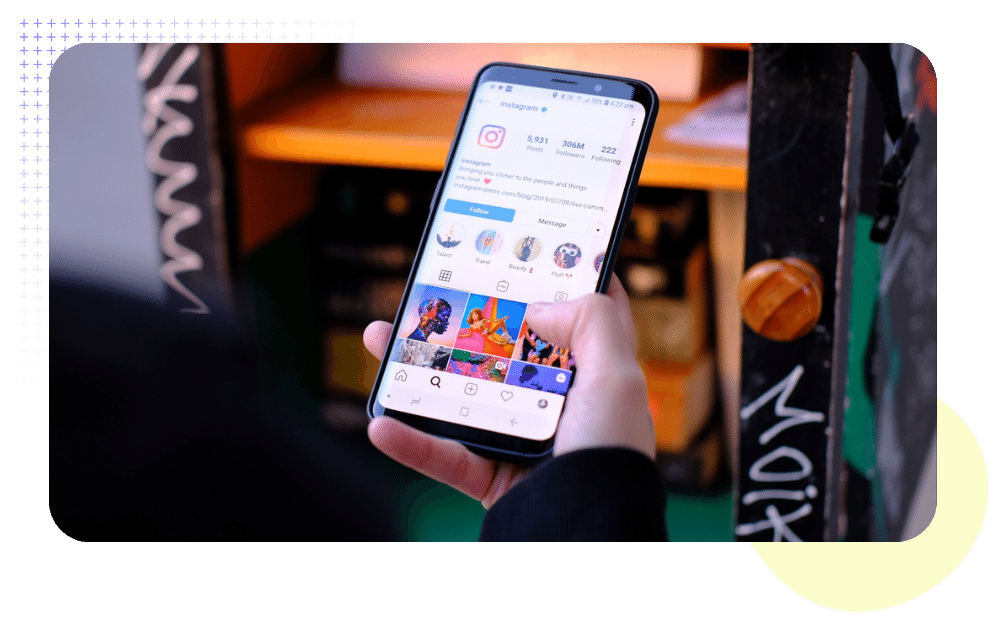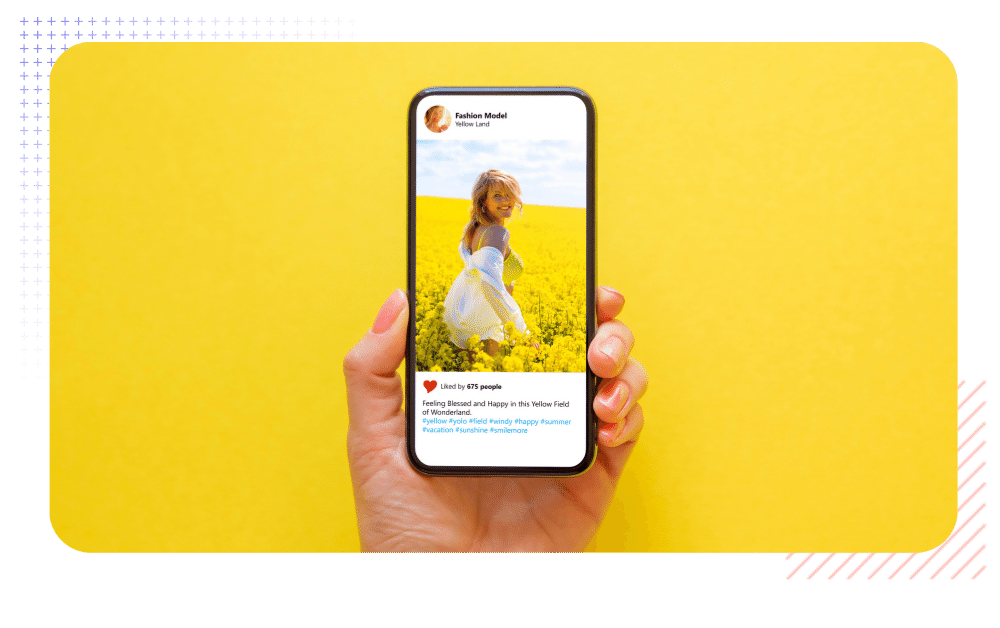Every successful influencer marketing campaign starts with a strategy. Understandably you’re eager to start reaching out to influencers, but don’t skip the important first step of defining your influencer marketing strategy in line with your marketing goals.
In this guide, you’ll find everything you need to plan a winning influencer marketing strategy! We’ll equip you with key knowledge about types of campaigns, compensation models, and key performance indicators (KPIs) that will allow you to make important decisions up-front before you launch your campaign.
You’ll learn:
- The benefits of influencer marketing
- How to set KPIs
- How to plan the right type of campaign for your needs
- Which influencer compensation model to choose
- How to create a relevant influencer brief
- How to approach influencer outreach
What is influencer marketing?

Influencer marketing is a strategy where brands partner with social media influencers to advertise their brand through authentic recommendations.
In short, influencer marketing takes the main principles of word-of-mouth marketing and amplifies it across social media to boost brand growth.
How does influencer marketing work?
Influencers promote a brand’s products to their social media followers through authentic content such product reviews, unboxing videos and sponsored social posts. They create promotional content in exchange for free products or a monetary payment. Influencer marketing is a valuable marketing strategy that enables brands to leverage the wide reach, trustworthiness, popularity and credibility of influencers to raise brand awareness and drive sales.
What are the benefits of influencer marketing?
Influencer marketing helps businesses to drive real results by harnessing influencers’ authentic content to build connections with new customers.
Influencers are influential because they know how to mobilize their audience and get key messages in front of your target customers. This makes them key partners for brands who are looking to build their online presence and reach new audiences.

Influencer marketing is word-of-mouth marketing at scale. It works so well because influencers are seen as credible industry experts, whose lifestyles their followers want to emulate. Influencer product recommendations have real power to drive conversions because their followers seek out recommendations from influencers they trust. As a result, customers are far more likely to convert due to influencer-generated content than posts from your brand’s business account.
Product endorsements and testimonials are a tried and tested strategy that works. Yet, influencer marketing takes it to the next level by communicating directly with target customers. Influencer marketing promotes your brand in a non-intrusive way. Influencers know how to make their sponsored content fit seamlessly into their feed so that it doesn’t look or feel like an ad.
Influencers can help brands achieve real business outcomes and growth by driving sales. People are spending more time online, and more specifically on social media. As such, the entire commerce journey is now happening online. People look to influencers not just for entertainment but as trend-setters and taste-makers who are ahead of the curve in shopping trends. People look to their favorite influencers for product recommendations. As a result, creators are driving not only product discovery but conversions too. Inmar reported that 84% of people had made a purchase as a result of an influencer recommendation.
How do you create an influencer marketing strategy?

Now you understand what influencer marketing is, and why you should prioritize it within your overall marketing strategy, let’s dive into what steps you need to take to create an influencer marketing strategy.
The key steps to creating an influencer marketing strategy:
- Set your influencer marketing goals.
- Decide your KPIs so that you can measure success.
- Choose which type of influencer campaign will help you meet your goals.
- Plan your influencer marketing budget.
- Create an influencer brief to decide key messages and compensation.
- Plan your influencer outreach strategy.
With all these elements in place you’ll be ready to start influencer recruitment and begin running your influencer marketing campaigns!
The rest of this guide will dive into each of these steps in more detail.
Setting goals and KPIs
The first stage of creating an influencer marketing strategy is to define your goals and KPIs. Your campaign goals will dictate the criteria for your influencer selection, KPIs and so much more. That’s why goal-setting comes before choosing content creators! After all, both you and your influencers will need to fully understand your aims in order to deliver the results. Don’t forget, your influencer marketing goals will be tied directly to your overall marketing goals. These might include:
- Brand awareness
- Brand engagement
- Drive online sales or signups
- Boost customer loyalty and repeat business
Having a clear goal establishes a framework for the campaign and allows you to set relevant KPIs. For example, for an awareness campaign, the KPI could be a spike in new followers, web traffic, or brand mentions. For sales campaigns, measure conversions such as promo code use, subscriptions, downloads, or traffic from affiliate links.
The table shows which influencer marketing campaign KPIs can be used to measure success according to different campaign goals. Looking at several KPIs together will build up a bigger picture of your overall performance. You should also consider KPIs based on the content formats and campaign type. For example, if you’re collaborating with an influencer on Twitch, there are some KPIs that are specific to Twitch such as Average Concurrent Views or Unique Viewer Peak.

Understanding the types of influencer marketing campaigns
Influencer marketing is an incredibly versatile strategy that can be endlessly adapted and personalized. This means that influencer activations can be designed to help you reach your goals.
For example, if you want to generate sales then focus on content that converts instead of educational content, and be sure to include trackable links to measure sales!
Common types of influencer marketing campaigns
Sponsored campaign
Why use it: This is the classic form of influencer marketing that can be easily used for cross-channel promotions and scaled by working with several influencers at once. Brands maintain control of messaging and content guidelines while influencers take care of content production. Brands usually offer a flat fee, so you know up-front how much they will pay to compensate influencers.
Product seeding
Why use it: Promote the launch of a new product or a particular product line by sending it out to influencers in exchange for promotional content. You’ll get authentic content based on influencers’ real experiences using your products. Product seeding a great way to activate micro-influencers and lay the foundation for future campaigns. For brands who don’t have a huge budget to dedicate to paying influencers, then product seeding is a good entry point into influencer marketing.
Giveaway competition
Why use it: Influencers are more likely to accept your campaign proposal if you have something to offer their audience. By hosting a giveaway, influencers will promote your brand and give something valuable back to their audience to keep them engaged – it’s a win-win for everyone!
Affiliate marketing
Why use it: Affiliate programs with influencers is a great way to drive sales among a new customer base. Influencers will help you have a broad reach and drive even more conversions. Using trackable affiliate links allows you to easily measure and attribute sales.
Product collaboration
Why use it: Collaborating with an influence to design and create a brand new product for your business is a surefire way to boost sales! Brands can harness an influencer’s popularity and personal style to boost awareness and conversions by launching a unique and highly desirable product.
Seasonal campaigns
Why use it: Stay top of mind with new and potential customers by tapping into seasonal events and holidays. Promote your seasonal product range or highlight how your business ties in with the traditions and celebrations of a certain time of year to boost conversions and capitalize on seasonal shopping trends.
Brand ambassador
Why use it: Build a network of brand champions who will work with you on a long-term basis to promote your products. Harness organic authenticity by collaborating with influential customers who already love your brand by turning them into influencers and ambassadors for your business.
Creating an influencer brief

What is an influencer brief?
An influencer brief is an important document that sets out clear guidelines, expectations, and instructions related to your campaign. It ensures that the influencer has all the necessary information to be able to carry out the campaign to the standards expected and ensures both parties are on the same page.
In addition to being informative, it should also get the influencer excited about your brand, the campaign, and their role.
What to include in an influencer brief
- Introduction to your company: What are your values? What does your company do? Why should they work with you? Include links to your social media accounts and website, photos of your products, and past collaborations.
- Campaign summary: Explain the goals of your campaign, what is being promoted, why, and how?
- Content instructions: Format, networks, hashtags, key messages, key publication dates, dos, and don’ts, etc
- Moodboard or inspiration: Give examples of what you’re looking for, and introduce influencers to your branding and esthetics.
- Compensation and payment: State clearly how influencers will be compensated for their work whether through payment, product, or a mix of both!
A great campaign brief leaves the influencer some room for creative freedom. The beauty of working with an influencer is that they know their audience better than anyone. They know exactly what kind of content will generate the most engagement. By all means offer guidelines, but remember to let your creators communicate authentically with their audience.
Planning an influencer marketing budget
The backbone of a great influencer marketing strategy is a well-planned budget that helps you invest in the right influencers, processes, and tools that will deliver results and a high ROI. Planning your influencer marketing budget should take into consideration several factors including influencer compensation, cost of software and tools, and paid amplification.

Influencer marketing budgets will vary according to the number of influencers you work with, the category of influencers, and the type of campaign you’re running. More than half of marketers spend less than $50K on influencer marketing. In fact, the most common annual influencer marketing budget is between $1,000 – $10,000.
4 key factors affecting your influencer marketing budget

Influencer compensation model
A large part of your overall influencer budget will be dedicated to compensating influencers so it’s important to consider how you’ll pay them. There is no magic formula that tells you how much to pay influencers. But you have several options depending on how much you have to spend and your goals.
The most common compensation models include:
Free products
Send your influencers free product samples to try in exchange for creating content. It’s a great choice for brand awareness campaigns and is best suited to nano, micro, or organic influencers who are aligned with your brand values. It’s a strategic choice for ROI since products have a high perceived value but a lower monetary cost to the brand.
Flat fee
You can offer a flat monetary fee based on your expectations in terms of the amount of content and the efforts needed for content production. It’s useful as you’ll know exactly how much you’ll need to spend, yet it’s difficult to predict the performance of an influencer’s content which could negatively impact ROI.
Performance-based fee
This is becoming more common as it minimizes risks for brands and means influencers are fairly compensated based on their performance. You’ll need to define which KPIs you’ll measure up-front, and use cost-per-click, cost-per-acquisition, or cost-per-engagement to determine how much you’ll pay your creators.
Revenue-sharing
Influencers will receive a percentage of the profits from the sales they generate directly for your brand. This is appealing for influencers who can earn more than they might make with a one-off payment and smart for brands since compensation depends on concrete results.
Compliance and legal fees
Depending on the nature of your campaign you may need to factor in fees associated with drawing up contracts, non-disclosure agreements, or exclusivity agreements.
If you want an influencer to work exclusively with your brand, you can expect to pay extra fees as they will need to compensate for the income lost due to turning down other collaborations.

In addition, if you plan on working with an influencer long-term or on projects with large payout sums, ensuring your contract and brief have specific legal guidelines in place that prevent non-compliance and outline all disclosure expectations of the influencer is of critical importance.

Influencer marketing software fees
Budgeting for the use of influencer marketing software (such as Upfluence) can help save you time and resources when running influencer campaigns.
While it will require budgeting for some up-front or monthly costs, paying for a dedicated, all-in-one tool will pay off in the long run.
What’s more, you’ll increase your capacity for running campaigns in-house. It will be possible to recruit more influencers and run even more campaigns simultaneously without the need to hire or train more staff.
Paid campaigns
You may decide to amplify your influencer marketing campaign by paying for media space such as social media ads, retargeting ads, and press distribution. By combining influencer marketing with paid media campaigns you can make sure that high-converting, influencer-generated content can be maximized across all marketing channels and drive more results for your brand.
That’s why it’s important to decide whether you want to allocate part of your marketing budget to amplifying your influencer marketing efforts across paid channels.

How to approach influencers
Deciding an outreach strategy is an important part of your overall campaign strategy. You should have a clear idea about how many influencers to work with, when you’ll reach out and how you’ll get them on board with your campaign. Unless your brand is as well-known as the likes of Coca-Cola, it’s likely that most influencers won’t have heard of your brand. They won’t know anything about your values, or your products. This means it’s vital to nurture a relationship from the start and get them excited about working with you.
When you’re starting out with influencer marketing, it’s a good idea to hire a larger volume of smaller influencers to manage your budget and identify the best ones for future partnerships.
It’s wise to start contacting influencers months in advance of your campaign. Especially for seasonal campaigns if you want to guarantee that your influencers will be available at the right moment or if you want to work with top influencers who often plan their content months ahead. Don’t forget to factor in time for negotiation too!

Value proposition
Making an attractive proposal to new influencers is crucial to getting them interested in working with your brand. You should create a value proposition that provides an incentive to influencers by detailing what value your brand has to offer them in terms of compensation, free products, promotional codes to share with their audience, and any other perks of joining your brand’s influencer network.
You should show your creators how working with your brand will align with their content and be of interest to their audience. This will convince them that partnering with your brand is a worthwhile project.
A convincing value proposition is a win-win for everyone: It should incentivize influences to become long-term collaborators while maximizing campaign ROI.
Conclusion
This guide to planning your influencer marketing strategy has taken you through the key areas you need to plan with your marketing team before embarking on an influencer campaign. Knowing your goals, how much you’ll spend and the parameters of your campaign will help you to save time when it comes to launching your campaign.


















